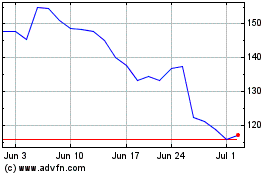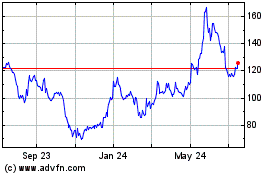Interim data show vaccination with mRNA-1653
boosted serum neutralization titers against hMPV and PIV3 at all
dose levels tested and was generally well tolerated
Company plans to advance mRNA-1653 into a Phase
1b study in seropositive pediatric subjects
Conference call to be held at 5:00 p.m. ET
today
Moderna, Inc., (Nasdaq: MRNA) a clinical stage biotechnology
company pioneering messenger RNA (mRNA) therapeutics and vaccines
to create a new generation of transformative medicines for
patients, today announced topline data from the first planned
interim analysis of safety and immunogenicity from its Phase 1
study of mRNA-1653 in healthy adults. mRNA-1653 is a wholly-owned
program in Moderna’s prophylactic vaccine modality.
mRNA-1653 is designed to protect against human metapneumovirus
(hMPV) and parainfluenza type 3 (PIV3), two viruses that cause
respiratory infections. It is a combination vaccine that consists
of two distinct mRNA sequences encoding the fusion (F) proteins of
hMPV and PIV3 formulated in Moderna’s proprietary lipid
nanoparticle (LNP) technology.
“There are no approved vaccines to prevent hMPV or PIV3
infections, which are significant causes of severe respiratory
diseases and hospitalizations for infants and children,” said Tal
Zaks, M.D., Ph.D., chief medical officer at Moderna. “Based on
these positive interim Phase 1 data, we are excited to further
advance mRNA-1653 into pediatrics as the first combination vaccine
to focus on both hMPV and PIV3.”
These Phase 1 interim data show that a single vaccination with
mRNA-1653 boosted serum neutralization titers against hMPV and
PIV3, and that the magnitude of the boost was similar at all dose
levels tested. Consistent with prior exposure to hMPV and PIV3, all
study participants had neutralizing antibodies against both viruses
at baseline. One month after a single mRNA-1653 vaccination, the
hMPV neutralization titers were approximately six-fold baseline and
PIV3 neutralization titers were approximately three-fold baseline
(based on geometric mean ratios). A second mRNA-1653 vaccination
one month after the first vaccination did not further boost
antibody titers, suggesting a single vaccination was sufficient to
achieve a plateau in neutralizing antibodies in this pre-exposed
population.
mRNA-1653 was found to be generally well tolerated. No serious
adverse events (SAEs), adverse events of special interest, or
adverse events leading to withdrawal were reported. Injection site
pain was the most commonly reported adverse event and the most
common Grade 3 adverse event.
Much of Moderna’s commercial vaccine development efforts are
focused on addressing major causes of respiratory infections,
including hMPV+PIV3 and respiratory syncytial virus (RSV). These
infections share many of the same features, often causing upper and
lower respiratory tract illness, characterized by wheezing,
bronchiolitis and pneumonia and are associated with a substantial
burden of hospitalizations and outpatient visits among children
throughout the first five years of life. There are currently no
approved vaccines for hMPV, PIV3 or RSV.
Conference Call
Moderna will host a conference call and webcast today at 5:00
p.m. ET to discuss these interim data and the Company’s broader
efforts to develop respiratory vaccines. Participants are invited
to listen by dialing (866) 922-5184 (domestic) or (409) 937-8950
(international) and providing conference ID 3580988 or join the
live webcast by going to the "Events and Presentations" area on the
Investors page of the Company's website, www.modernatx.com. An
archived webcast of the conference call can also be accessed
through the Company’s website and a replay of the call will be
available there for four weeks after the call.
About the Study
mRNA-1653-P101 is a Phase 1, first-in-human, randomized,
observer-blind, placebo-controlled, dose-ranging study in healthy
adults. The trial’s key objectives include evaluating the safety
and tolerability, reactogenicity and humoral immunogenicity of
mRNA-1653, and selecting the optimal dose and vaccination schedule
for further clinical development. This study is being conducted in
the United States, and enrolled 124 subjects across four dose
levels of mRNA-1653 (25, 75, 150, and 300 µg) and placebo. Subjects
were randomized to a one-dose or two-dose vaccination schedule,
with the second vaccination of mRNA-1653 administered one month
after the first vaccination.
About Moderna’s Prophylactic Vaccines Modality
Moderna has 21 mRNA development candidates in its pipeline,
with 12 programs now in clinical development. These investigational
medicines are grouped together into six modalities based on similar
mRNA technologies, delivery technologies and manufacturing
processes. Typically, programs within a modality will also share
similar pharmacology profiles, including the desired dose response,
expected dosing regimen, target tissue for protein expression,
safety and tolerability goals as well as their pharmaceutical
properties.
Moderna scientists designed the Company’s prophylactic vaccines
modality to prevent or control infectious diseases. This modality
now includes nine programs, all of which are vaccines against
viruses. Some of these programs are designed for commercial use and
others for public health. The goal of any vaccine is to safely
pre-expose the immune system to a small quantity of a protein from
a pathogen, called an antigen, so that the immune system is
prepared to fight the pathogen if exposed in the future, and
prevent infection or disease.
Moderna currently has four development candidates for potential
commercial uses in this modality including: RSV (mRNA-1777 with
Merck), cytomegalovirus (CMV) vaccine (mRNA-1647), hMPV+PIV3
vaccine (mRNA-1653) and varicella zoster virus (VZV) vaccine
(mRNA-1278 with Merck).
Five development candidates in this modality are being explored
for potential global health uses including: influenza H10N8 vaccine
(mRNA-1440), influenza H7N9 vaccine (mRNA-1851), Zika vaccine
(mRNA-1325 and mRNA-1893 with BARDA) and chikungunya vaccine
(mRNA-1388 with DARPA).
About hMPV and PIV3
hMPV was discovered in 2001 as the cause of acute respiratory
infections in up to 15 percent of patients. The virus primarily
affects young children but can also infect adults, the elderly and
those who are immunocompromised. Symptoms range from a mild upper
respiratory tract infection to life-threatening severe
bronchiolitis and pneumonia. Despite the need, there is currently
no approved vaccine for hMPV.
Infections from PIV account for up to seven percent of acute
respiratory infections among children younger than five years of
age. Of the four PIV types identified, PIV3 most frequently results
in infections and leads to the more serious lower respiratory tract
infections. Though PIV3-related infections were identified in the
past, their burden to patients and hospitals has been elevated over
the past few years. There is currently no approved vaccine for
PIV3.
About Moderna
Moderna is advancing messenger RNA (mRNA) science to create a
new class of transformative medicines for patients. mRNA medicines
are designed to direct the body’s cells to produce intracellular,
membrane or secreted proteins that have a therapeutic or preventive
benefit with the potential to address a broad spectrum of diseases.
Moderna’s platform builds on continuous advances in basic and
applied mRNA science, delivery technology and manufacturing,
providing the Company the capability to pursue in parallel a robust
pipeline of new development candidates. Moderna is developing
therapeutics and vaccines for infectious diseases, immuno-oncology,
rare diseases and cardiovascular diseases, independently and with
strategic collaborators.
Headquartered in Cambridge, Mass., Moderna currently has
strategic alliances for development programs with AstraZeneca, Plc.
and Merck, Inc., as well as the Defense Advanced Research Projects
Agency (DARPA), an agency of the U.S. Department of Defense and the
Biomedical Advanced Research and Development Authority (BARDA), a
division of the Office of the Assistant Secretary for Preparedness
and Response (ASPR) within the U.S. Department of Health and Human
Services (HHS). Moderna has been ranked in the top ten of Science’s
list of top biopharma industry employers for the past four
years. To learn more, visit www.modernatx.com.
Special Note Regarding Forward-Looking Statements
This press release contains forward-looking statements within
the meaning of the Private Securities Litigation Reform Act of
1995, as amended including, but not limited to, statements
concerning: the design, safety profile, tolerability and
future expectations regarding mRNA-1653; the Company’s plans to
advance mRNA-1653 into a Phase 1b study; and the final and expected
outcomes of Moderna’s other clinical trials. In some cases,
forward-looking statements can be identified by terminology such as
“will,” “may,” “should,” “expects,” “intends,” “plans,” “aims,”
“anticipates,” “believes,” “estimates,” “predicts,” “potential,”
“continue,” or the negative of these terms or other comparable
terminology, although not all forward-looking statements contain
these words. The forward-looking statements in this press release
are neither promises nor guarantees, and you should not place undue
reliance on these forward-looking statements because they involve
known and unknown risks, uncertainties and other factors, many of
which are beyond Moderna’s control and which could cause actual
results to differ materially from those expressed or implied by
these forward-looking statements. These risks, uncertainties and
other factors include, among others: whether the interim results
for mRNA-1653 will be predictive of the final results for the
ongoing study or any future clinical studies; whether
mRNA-1653 will be unsafe or intolerable during further clinical
studies, particularly studies involving pediatric subjects; the
fact that clinical development is lengthy and uncertain, especially
for a new class of medicines such as mRNA, and therefore our
clinical programs or development candidates may be delayed,
terminated, or may never advance; no mRNA drug has been approved in
this new potential class of medicines, and may never be approved;
mRNA drug development has substantial clinical development and
regulatory risks due to the novel and unprecedented nature of this
new class of medicines; and those described in Moderna’s Prospectus
filed with the U.S. Securities and Exchange
Commission (SEC) on December 7, 2018 and in
subsequent filings made by Moderna with the SEC,
which are available on the SEC's website
at www.sec.gov. Except as required by
law, Moderna disclaims any intention or responsibility
for updating or revising any forward-looking statements in this
press release in the event of new information, future developments
or otherwise. These forward-looking statements are based on
Moderna’s current expectations and speak only as of the date
hereof.
View source
version on businesswire.com: https://www.businesswire.com/news/home/20190212005810/en/
Moderna Contacts:Investors:Lorence KimChief
Financial Officer617-209-5849Lorence.kim@modernatx.com
Media:Jason GlashowHead, Corporate
Communications617-674-5648Jason.glashow@modernatx.com
Moderna (NASDAQ:MRNA)
Historical Stock Chart
From Mar 2024 to Apr 2024

Moderna (NASDAQ:MRNA)
Historical Stock Chart
From Apr 2023 to Apr 2024
